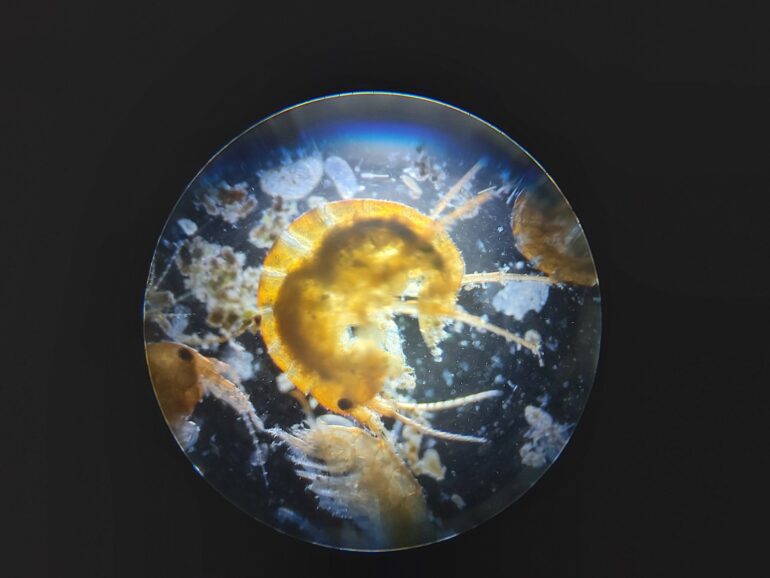In an ancient hot spring haunt of Incan rulers, researchers discovered a new species of tiny, shrimp-like scavengers known as amphipods thriving at record temperatures that can cook other crustaceans to death.
Although called freshwater shrimps, amphipods are not true shrimps. Typically, they dwell in cool aquatic and semi-aquatic habitats. So Japanese and Peruvian researchers were stunned when unidentified Hyalella species showed up during a hot spring biota survey of Baños del Inca (Baths of the Inca) near the ancient Inca city of Cajamarca.
“Though the amphipod is a taxon with a great diversity of habitats, the discovery of a new species from a previously unexpected high-temperature environment is most surprising,” said study corresponding author Ko Tomikawa, professor at Hiroshima University’s (HU) Graduate School of Humanities and Social Sciences.
“This is an important finding because it indicates that the diversity of habitats for amphipods is much greater than previously thought.”
The new species was given the scientific name Hyalella yashmara after the two daughters of one of the researchers. Hyalella is a genus of amphipods endemic to the Americas.
Shared similarities, distinct differences
Researchers noted that H. yashmara is most similar to another Peruvian amphipod species called H. meinerti. Among the similarities they share are having a head with eyes and an upper dorsal antenna shorter than the lower ventral antenna.
But it also differs from its counterparts when it comes to its gnathopods 1 and 2, claw-bearing limbs used for feeding, grasping mates, and moving; respiratory structures called sternal gills; uropod 3, a part of the tail fan; and telson, or tail plate, shape. A detailed description of the new species was published in the journal Invertebrate Systematics.
Clues to adapting to climate change
Like its cold-dwelling counterparts, experiments showed H. yashmara can swim around cooler waters of 19.8°C (67.64°F). Although it can’t survive habitats colder than that for more than 24 hours.
Temperatures at Baños del Inca hit around 78°C (172.4°F) closest to the thermal spring’s origin. Field surveys revealed that these amphipods hang around pools simmering at 50°C (122°F) not far off the hot spring’s source and in channels cooled down to 35°C (95°F).
But they do seem to like it hot. Researchers noticed that these creatures are virtually inert early in the morning when temperatures are between 35–40°C (95–104°F) and bustling with activity as it grows warmer during the day.
Tests revealed they can survive temperatures of up to 52.1°C (125.78°F), the hottest recorded for amphipods. Such a temperature is enough to cook other crustaceans, including some of its shrimp cousins to death.
“Many animals cannot tolerate high-temperature environments because proteins are thermally denatured at high temperatures. We guess the new species found in the hot spring of Peru has acquired a protein that is highly active at high temperatures during the course of evolution,” Tomikawa explained.
Unraveling its unique adaptations can give clues on bolstering the heat tolerance of freshwater animals threatened by our warming climate.
“Rising water temperatures due to recent global warming pose a threat to the survival of freshwater organisms that prefer cold water environments. Detailed studies on the ecology and physiology of Hyalella yashmara may reveal the mechanism of high-temperature tolerance in crustaceans,” Tomikawa said.
“This information is of great importance as a basis for the conservation of cold-water freshwater organisms.”
Untangling its Gondwana origin story
Results of their molecular phylogenetic analyses, a method of studying evolutionary relationships based on genetic material, revealed a common Gondwanan ancestor for amphipods in the families Hyalellidae, where Hyalella species belong, and Chiltoniidae, which are abundant in Australia and New Zealand. Gondwana is the ancient supercontinent that clumped together the present-day continents of South America, Africa, and Australia.
That ancestor abandoned the sea to colonize new freshwater habitats during the Mesozoic age (about 252–66 million years ago)—the period when Earth’s single landmass known as Pangaea started drifting apart to form the continents we know today.
The analyses also suggested that the species of Hyallela in South America originated from different ancestors. Meanwhile, the species in North America likely share a most recent common ancestor with H. yashmara.
“The discovery of this new species proposes a new story of the distributional expansion of the genus Hyalella. Molecular phylogenetic analyses have revealed that the distribution of Hyalella likely expanded from South America to North America as a result of the introduction of a South American clade closely related to Hyalella yashmara into North America,” Tomikawa said.
Their molecular phylogenetic analyses covered 34 species of the nine families in the superfamily Hyaloidea and four of the two families in the superfamily Talitroidea.
More information:
Ko Tomikawa et al, Description of a new thermal species of the genus Hyalella from Peru with molecular phylogeny of the family Hyalellidae (Crustacea, Amphipoda), Invertebrate Systematics (2023). DOI: 10.1071/IS22060
Provided by
Hiroshima University
Citation:
In an ancient hot spring haunt of Inca rulers, scientists discover a new freshwater shrimp-like species (2023, October 19)



